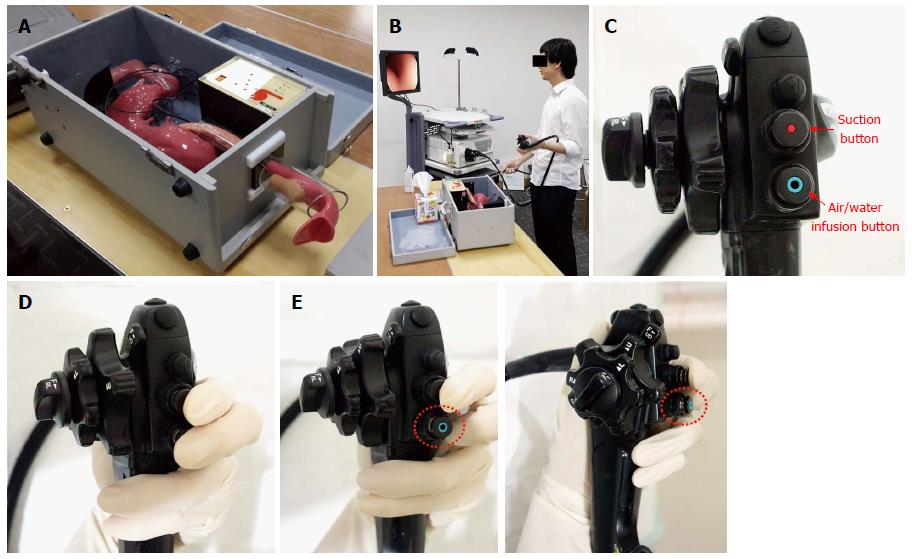Copyright
©The Author(s) 2015.
World J Gastroenterol. Jan 21, 2015; 21(3): 759-785
Published online Jan 21, 2015. doi: 10.3748/wjg.v21.i3.759
Published online Jan 21, 2015. doi: 10.3748/wjg.v21.i3.759
Figure 11 Intubation of scope from oral cavity into pharynx.
A: The human body model for esophagogastroduodenoscopy (EGD) training; B: Practicing the endoscopic procedure using a model of a human body. This human body model is specially designed for EGD training, and if beginners practice EGD using a human body model, it will be helpful for them to acquire and improve their capacity to perform the procedure; C: The control part of the endoscope has several buttons to manipulate various functions. Among them, there are two buttons that play a critical role in relation to the procedure; the “suction button” and the “air/water infusion button”; D: When one is advancing the scope, it is recommended to place the second and third fingers on the suction button and the air/water infusion button, respectively, after inserting the distal tip into the upper esophagus. The reason for placing the fingers on the buttons is to continuously insufflate air into the lumen during the upper GI endoscopy; of course, an excessive air infusion is absolutely taboo, and in that case, an endoscopist should stop air insufflation and begin to suction the air. Another reason is it makes it easier to immediately suction liquid or air whenever it is judged to be necessary by the examiner; E: The recommended position of the third finger until advancement into the upper esophagus (the cervical part of esophagus). As mentioned above, if a finger is placed on the air/water infusion button (that is to say, if the vent is blocked by a finger), this itself can irritate the airway (trachea) and trigger coughing and vomiting reflexes. As the air insufflation and water infusion use the same channel, a few droplets of water can be released when an examiner starts to do an air infusion, which can also cause coughing or vomiting reflexes. Therefore, it is recommended that an examiner not block the vent on the top of the air/water infusion button with the third finger of the left hand, until the distal tip reaches the entrance of the upper esophagus, as shown in the picture.
- Citation: Lee SH, Park YK, Cho SM, Kang JK, Lee DJ. Technical skills and training of upper gastrointestinal endoscopy for new beginners. World J Gastroenterol 2015; 21(3): 759-785
- URL: https://www.wjgnet.com/1007-9327/full/v21/i3/759.htm
- DOI: https://dx.doi.org/10.3748/wjg.v21.i3.759









